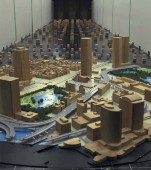Skyscraper Tube: Architecture and Construction Aerodynamics for Unique Buildings and Structures

A wind is one of the factors that require attention during the design of unique buildings and structures, building of complex architectural forms. However, the current Russian and foreign building codes do not contain recommendations for the aerodynamic coefficients assignment for the determination of the calculated wind loads on structures for such buildings and prescribe in these cases using the results of tests in specialized wind tunnels.
Wind tunnels of architectural and construction type designed for this type of testing exist in research laboratories in Europe, Japan, USA (Scientific and Technical Centre for Building, Politecnico di Milano, Technische Universität Berlin, The University of Tokyo, NASA). The main feature of the tunnel design of this type is the presence of an extended working area (not less than 15 m), which provides a special rate curve blown flow modeling the surface layer of the atmosphere and the effect of the underlying surface of the landscape.
In 2008, at the Moscow State University of Civil Engineering based at Training, Research and Production Laboratory of Wind-tunnel and Aeroacoustic Testing of Civil Engineering Structures (UNPL AAISK) together with the Ministry of Education and Science of the Russian Federation and the Government of Moscow the wind tunnel that meets modern requirements and designed to address issues of architectural and construction aerodynamics was started to design, and in 2012 this tunnel was put into operation.
Measuring equipment base is essential for successful study of wind effects on buildings and structures with all the architecture features and city accommodation. The base includes both classical measurement systems based on the differential pressure sensors and six-component silo-torque sensors using and advanced laser noncontact measuring systems (PIV and LDA). In addition, the basis of high-rise building qualitative research is construction itself of Big gradient wind tunnel UNPL AAISK MGSU (hereinafter - BGAT MGSU). At its creation, the recommendations of Russian specialists and world experience operating similar subsonic pipes were taken into account, such as the elimination of irregularities diagrams velocity modulus in the horizontal section and profiling flow of the medium in turning parts of the circuit (90 degrees) using the guide vanes.
It is also necessary to note that, BGAT MGSU has a closed circulation loop and modular fan unit of the nine units, with a length of pipe 41 meters and length of the working area in the working area of 18.9 meters.
Full content of this issue you can read here
The full version of the article can be read in our printed issue, also you can subscribe to the web-version of the magazine
 Text: Olga Poddaeva, PhD, Associate Professor,
Text: Olga Poddaeva, PhD, Associate Professor,
Director, Training, Research and Production Laboratory
of Wind-tunnel and Aeroacoustic Testing
of Civil Engineering Structures,
Moscow State University of Civil Engineering (MGSU)


